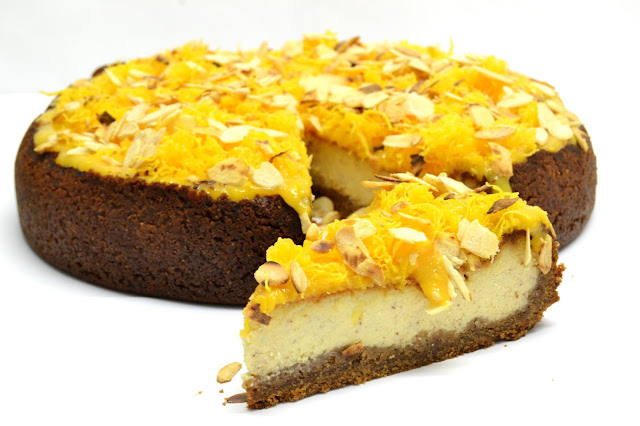Cheesecakes - a teoria para a perfeição || Cheesecakes - The Theory of Perfection
quarta-feira, junho 07, 2017
Se já procurou uma receita de cheesecake na internet, com certeza ficou perdido com a quantidade de variações, não meniconando ainda as variações de sabores. Algumas incluem gelatina, amido, leite condensado, natas.
É difícil escolher, por isso, não desista. Siga as dicas que mencionamos e será realmente fácil fazer um cheesecake perfeito - só precisa entender alguns princípios básicos.
A base
A base tradicional do cheesecake é feita com bolachas tipo “Maria” esfareladas e manteiga. Esta bolacha é basicamente farinha de trigo, óleo, açúcar e baunilha. E por que usamos a bolacha? Quando utilizamos a bolacha não precisamos pré-assar a massa da base do cheesecake, pois a base teria um tempo e uma temperatura de preparo muito diferente do recheio, o que impossibilitaria assá-los simultaneamente.
É importante que a bolacha fique bem esfarelada, semelhante a um pão ralado. Desta forma, a base será bem compacta e não quebrará. Pode adicionar vários ingredientes na base como, gengibre, canela, chocolate, nozes, avelãs, amendoins, amêndoas, etc. Lembre-se: sempre bem moídos para não quebrar!
O creme
O cheesecake não é um bolo. Apesar do nome “cake”, ele é um tipo de custard ou creme de pasteleiro. Os seus ingredientes essenciais são ovos, açúcar, leite ou natas, aromatizados com baunilha.
No caso do cheesecake, o cream cheese (creme de queijo) substitui uma parte das natas da receita básica.
Qual o segredo do cheesecake? É a combinação dos ingredientes essenciais na proporção correta e assados em temperatura moderada.
Vamos entender então a função de cada ingrediente...
A clara de ovo e as natas dão estrutura. As proteínas coagulam quando aquecidas, formando uma rede que retém o líquido, tornando-se um gel delicado.
As gemas são responsáveis pelo efeito cremoso e emulsificante, pois possuem lecitina, um tipo de gordura que pode misturar duas coisas aparentemente imiscíveis (que não se misturam), água e óleo.
O açúcar interfere no processo de coagulação, aumentando a temperatura de coagulação do creme para 70°C a 80°C, bem abaixo do ponto de ebulição da água. Se ultrapassar esse ponto, as proteínas do ovo perdem a sua forma, não retendo o líquido. O creme ficará coalhado. Por isso, a melhor forma de assar o cheesecake é com a técnica de banho maria. O cheesecake excessivamente assado tende a rachar.
Para uma assadura perfeita, devemos ter em consideração as proporções do mesmo: para um creme com quantidades de 600-800g de queijo creme e 3-4 ovos, o tempo de assadura deverá rondar cerca de 1h30, a 160-180ºC, conforme ligue ou não a ventilação do seu forno.
Para evitar que o topo seque, deve cobrir o cheesecake com folha de alumínio, evitando assim a caramelização directa pelo calor.
Ao fim de 1h30, destape com cuidado, e verifique a textura: se apresentar os rebordos bem firmes ao toque e o centro ligeiramente suave, sem estar líquido, pode desligar o forno e deixar o cheesecake repousar, até arrefecer. Por fim refrigere para estabilizar as ligações e desenforme.
Para uma assadura perfeita, devemos ter em consideração as proporções do mesmo: para um creme com quantidades de 600-800g de queijo creme e 3-4 ovos, o tempo de assadura deverá rondar cerca de 1h30, a 160-180ºC, conforme ligue ou não a ventilação do seu forno.
Para evitar que o topo seque, deve cobrir o cheesecake com folha de alumínio, evitando assim a caramelização directa pelo calor.
Ao fim de 1h30, destape com cuidado, e verifique a textura: se apresentar os rebordos bem firmes ao toque e o centro ligeiramente suave, sem estar líquido, pode desligar o forno e deixar o cheesecake repousar, até arrefecer. Por fim refrigere para estabilizar as ligações e desenforme.
Você pode adicionar sabor ao cheesecake substituindo parte do cream cheese por chocolate, doce de leite, ricota, puré de banana ou morango ou outra fruta, mas respeite sempre as proporções mencionadas.
A cobertura
Aqui é sua escolha. Cubra com uma cobertura de sua preferência: geleias ou coulis, frutas, chantilly, toffee, ganache.... Ou mesmo sem cobertura nenhuma, mas acompanhado de frutas vermelhos ou frutos da época bem frescos!
If you have already tried to find a recipe for cheesecake on the internet, you certainly got lost with the amount of variations, not even mentioning the variations of flavors. Some include gelatin, starch, condensed milk, cream...
It's hard to choose, so do not give up. Follow the tips we mention here and it will be really easy to make a perfect cheesecake - you just need to understand some basics.
The base
The traditional base of the cheesecake is made with biscuits type "tea biscuits" and butter. This biscuit is basically wheat flour, oil, sugar and vanilla. And why do we use the biscuits? When we use it we do not need to pre-bake the dough from the base of the cheesecake because the base would have a time and a preparation temperature very different from the filling, which would make it impossible to bake them simultaneously.
It is important that the biscuit is very crumbled, similar to breadcrumbs. This way, the base will be very compact and will not break. You can add various ingredients in the base like, ginger, cinnamon, chocolate, nuts, hazelnuts, peanuts, almonds, etc. Remember: always well ground to not break!
The Filling
The cheesecake is not a cake. Despite the name "cake", it is a type of custard or confectioner's cream. Its essential ingredients are eggs, sugar, milk or cream, flavored with vanilla.
In the case of cheesecake, cream cheese replaces a portion of the cream of the basic recipe.
What is the secret of cheesecake? It is the combination of the essential ingredients in the right proportion and baked at moderate temperature.
Let us then understand the function of each ingredient ...
Egg white and cream give structure. Proteins coagulate when heated, forming a net that retains the liquid, making it a delicate gel.
The yolks are responsible for the creamy and emulsifying effect, as they have lecithin, a type of fat that can mix two apparently immiscible (unmixed) things, water and oil.
Sugar interferes with the coagulation process, increasing the coagulation temperature of the cream to 70°C to 80°C, well below the boiling point of the water. If you go beyond this point, the egg proteins lose their shape, not holding back the liquid. The cream will be curdled. So the best way to bake the cheesecake is with water bath technique. Overly roasted cheesecake tends to crack.
For a perfect baking, we must take into account the proportions of the filling: for a filling with amounts of 600-800g cream cheese and 3-4 eggs, the baking time should be around 1h30, at 160-180ºC, depending on turning on or not the ventilation of your oven.
To prevent the top from drying out, cover the cheesecake with aluminum foil, thus avoiding direct caramelization by heat.
After 1:30, carefully uncover and check the texture: if the edges are firm to the touch and the center slightly soft, without being liquid, you can turn off the oven and let the cheesecake stand until cool. Finally refrigerate to stabilize the connections and unmold.
You can add flavor to the cheesecake by replacing part of the cream cheese with chocolate, dulce de leche, ricotta, banana puree or strawberry or other fruit, but always respect the mentioned proportions.
The Frosting
Here is your choice. Cover with a topping of your choice: jellies or coulis, fruit, whipped cream, toffee, ganache .... Or even no cover at all, but accompanied by berries or fresh fruits of the season!










1 apreciações
Com essas dicas todas não há como falhar. Agora tens que deixar mais algumas receitas para experimentarmos, pois essas fotos deixam qualquer um com água na boca ☺
ResponderEliminarObrigada por comentarem! Espero que testem e que aprovem! Beijinhos e bons conzinhados!